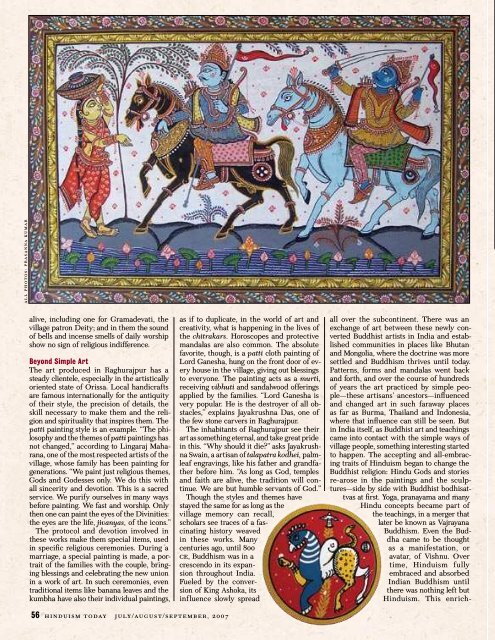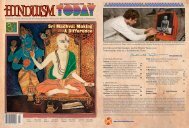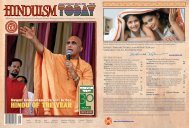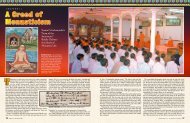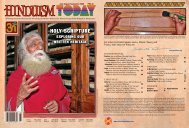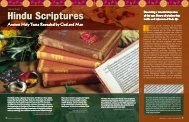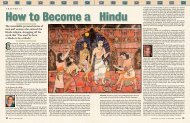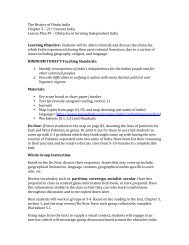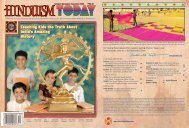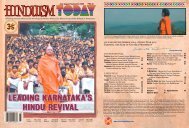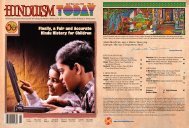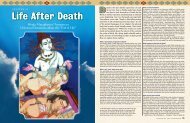Hinduism Today July 2007 - Cover, Index, Gatefold, Front Articles
Hinduism Today July 2007 - Cover, Index, Gatefold, Front Articles
Hinduism Today July 2007 - Cover, Index, Gatefold, Front Articles
You also want an ePaper? Increase the reach of your titles
YUMPU automatically turns print PDFs into web optimized ePapers that Google loves.
The Fading Ganjapa Game<br />
Mukunda Maharana, 83, is the village elder<br />
of Raghurajpur. When he was a young<br />
boy, he learned patti painting from his father,<br />
Gopinath, who insisted that the family<br />
legacy should survive, no matter what.<br />
Those were difficult days for art, before the<br />
spark had been rekindled by Mukunda’s<br />
uncle, Jagannath Maharana, who would<br />
later make their work internationally admired<br />
and acclaimed in festivals and exhibits.<br />
But Mukunda learned it even so, in the<br />
most traditional ways, and was initiated into<br />
the chitrakar’s ritualistic procedures and<br />
techniques. Among those ancient teachings<br />
that were imparted to him, knowledge that<br />
he can today teach to others in the village,<br />
there was a very unusual one: the knowledge<br />
of how to play the game of ganjapa.<br />
The beautifully drawn, circular ganjapa<br />
cards are sought as desirable pieces of art.<br />
Exotic, hand-made and unique, they make<br />
a fine souvenir for tourists or for export.<br />
The cards have paintings of Gods—Rama,<br />
Ganesha, Sarasvati, a North-Indian style<br />
depiction of Siva with a mustache—and of<br />
their divine mounts; painting of kings and<br />
courtiers, of Puranic characters and heroes.<br />
The game was mentioned in the memoirs<br />
of Emperor Babur, the first ruler of the Moall<br />
photos: prasanna kumar<br />
alive, including one for Gramadevati, the<br />
village patron Deity; and in them the sound<br />
of bells and incense smells of daily worship<br />
show no sign of religious indifference.<br />
Beyond Simple Art<br />
The art produced in Raghurajpur has a<br />
steady clientele, especially in the artistically<br />
oriented state of Orissa. Local handicrafts<br />
are famous internationally for the antiquity<br />
of their style, the precision of details, the<br />
skill necessary to make them and the religion<br />
and spirituality that inspires them. The<br />
patti painting style is an example. “The philosophy<br />
and the themes of patti paintings has<br />
not changed,” according to Lingaraj Maharana,<br />
one of the most respected artists of the<br />
village, whose family has been painting for<br />
generations. “We paint just religious themes,<br />
Gods and Godesses only. We do this with<br />
all sincerity and devotion. This is a sacred<br />
service. We purify ourselves in many ways<br />
before painting. We fast and worship. Only<br />
then one can paint the eyes of the Divinities:<br />
the eyes are the life, jivanyas, of the icons.”<br />
The protocol and devotion involved in<br />
these works make them special items, used<br />
in specific religious ceremonies. During a<br />
marriage, a special painting is made, a portrait<br />
of the families with the couple, bringing<br />
blessings and celebrating the new union<br />
in a work of art. In such ceremonies, even<br />
traditional items like banana leaves and the<br />
kumbha have also their individual paintings,<br />
as if to duplicate, in the world of art and<br />
creativity, what is happening in the lives of<br />
the chitrakars. Horoscopes and protective<br />
mandalas are also common. The absolute<br />
favorite, though, is a patti cloth painting of<br />
Lord Ganesha, hung on the front door of every<br />
house in the village, giving out blessings<br />
to everyone. The painting acts as a murti,<br />
receiving vibhuti and sandalwood offerings<br />
applied by the families. “Lord Ganesha is<br />
very popular. He is the destroyer of all obstacles,”<br />
explains Jayakrushna Das, one of<br />
the few stone carvers in Raghurajpur.<br />
The inhabitants of Raghurajpur see their<br />
art as something eternal, and take great pride<br />
in this. “Why should it die?” asks Jayakrushna<br />
Swain, a artisan of talapatra kodhei, palmleaf<br />
engravings, like his father and grandfather<br />
before him. “As long as God, temples<br />
and faith are alive, the tradition will continue.<br />
We are but humble servants of God.”<br />
Though the styles and themes have<br />
stayed the same for as long as the<br />
village memory can recall,<br />
scholars see traces of a fascinating<br />
history weaved<br />
in these works. Many<br />
centuries ago, until 800<br />
ce, Buddhism was in a<br />
crescendo in its expansion<br />
throughout India.<br />
Fueled by the conversion<br />
of King Ashoka, its<br />
influence slowly spread<br />
It runs in the families: Talent flows in the<br />
genes of the village’s 120 families. (clockwise<br />
from left) A patti cloth depicting a<br />
ancient story; unfinished murtis of the<br />
traditional smiling form of Lord Jagannath;<br />
a painting class; patti on dried coconuts; a<br />
card of the fabled ganjapa game<br />
all over the subcontinent. There was an<br />
exchange of art between these newly converted<br />
Buddhist artists in India and established<br />
communities in places like Bhutan<br />
and Mongolia, where the doctrine was more<br />
settled and Buddhism thrives until today.<br />
Patterns, forms and mandalas went back<br />
and forth, and over the course of hundreds<br />
of years the art practiced by simple people—these<br />
artisans’ ancestors—influenced<br />
and changed art in such faraway places<br />
as far as Burma, Thailand and Indonesia,<br />
where that influence can still be seen. But<br />
in India itself, as Buddhist art and teachings<br />
came into contact with the simple ways of<br />
village people, something interesting started<br />
to happen. The accepting and all-embracing<br />
traits of <strong>Hinduism</strong> began to change the<br />
Buddhist religion: Hindu Gods and stories<br />
re-arose in the paintings and the sculptures—side<br />
by side with Buddhist bodhisattvas<br />
at first. Yoga, pranayama and many<br />
Hindu concepts became part of<br />
the teachings, in a merger that<br />
later be known as Vajrayana<br />
Buddhism. Even the Buddha<br />
came to be thought<br />
as a manifestation, or<br />
avatar, of Vishnu. Over<br />
time, <strong>Hinduism</strong> fully<br />
embraced and absorbed<br />
Indian Buddhism until<br />
there was nothing left but<br />
<strong>Hinduism</strong>. This enriching<br />
exchange of cultures is displayed in full<br />
glory in the arts of Raghurajpur.<br />
56 hinduism today july/august/september, <strong>2007</strong> july/august/september, <strong>2007</strong> h i n d u i s m t o d ay 57


